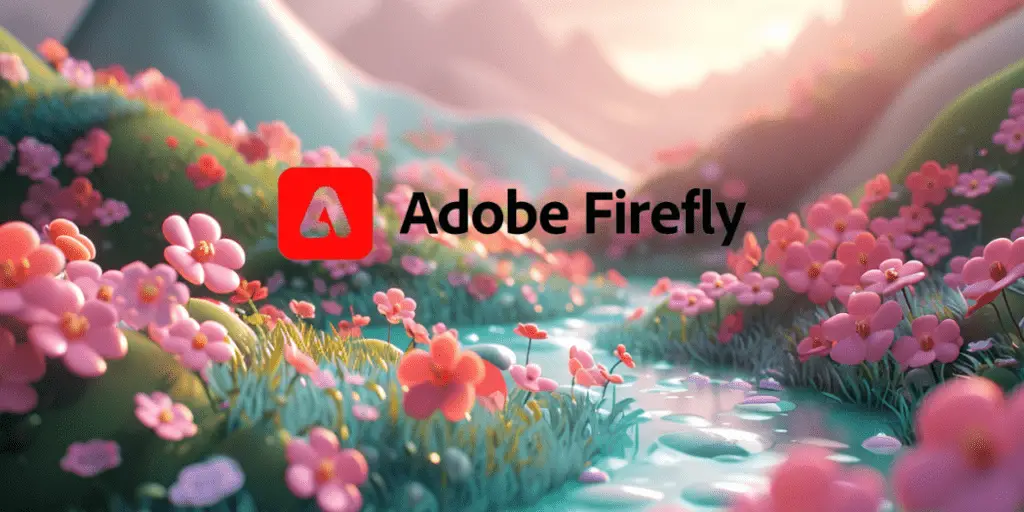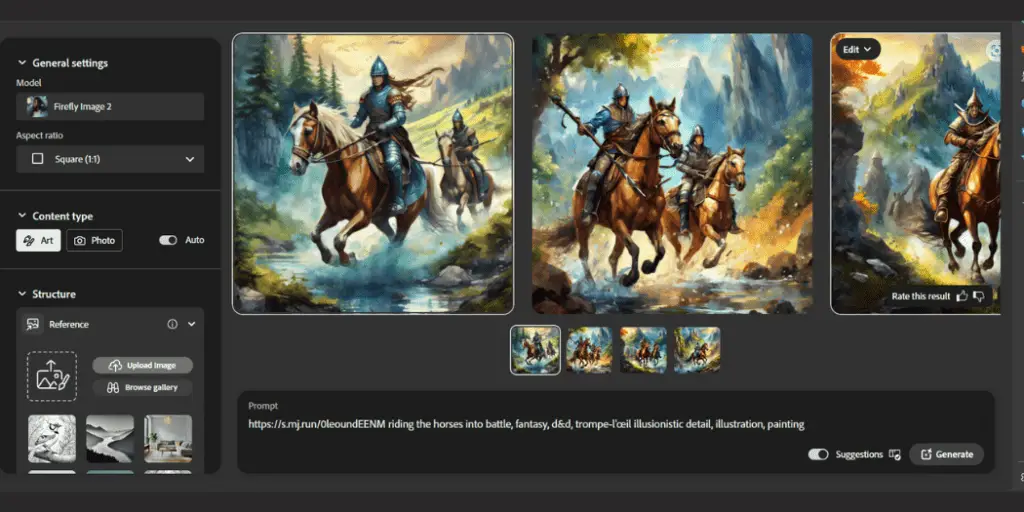Adobe has released its latest innovation, Adobe Firefly—a cutting-edge generative AI suite designed to transform the way creative professionals and hobbyists alike produce digital content.
Integrated seamlessly into Adobe’s famed Creative Cloud ecosystem, Firefly offers an array of powerful tools that simplify and enhance image generation, vector graphics creation, and even text effect applications through intuitive text prompts.
This tool not only promises to make digital creation more accessible but also significantly speeds up workflows across various Adobe applications such as Photoshop, Illustrator, and Adobe Express.
With Adobe Firefly Generative AI – Revolutionizing Creative Workflows, Firefly is set to redefine creative boundaries, offering unprecedented capabilities that cater to a global audience with support for over 100 languages.
Features of Adobe Firefly Generative AI
Adobe Firefly offers a suite of powerful features designed to enhance and simplify the creative process across multiple digital platforms.
Adobe Firefly leverages advanced AI technologies to allow users to create and edit images with unprecedented ease and flexibility. Generate entirely new pictures from textual descriptions, enabling quick conceptualization and realization of ideas.
Modify existing images by adding or removing elements, which can be particularly useful for content creators looking to tailor images to specific contexts or needs.
Expand images beyond their original borders, creating a seamless extension of the visual narrative without the need for extensive manual input.
Firefly extends its capabilities into the realm of vector graphics, which are integral for applications requiring scalability without loss of quality.
Text-to-vector transformations allow users to describe an element in words and receive a high-quality vector graphic in return.

This feature is especially beneficial in Adobe Illustrator, where users can efficiently create icons, logos, detailed illustrations, and patterns directly from a text prompt.
Adobe Firefly enhances Adobe Express and other design platforms by offering robust tools for creating dynamic digital communications.
Automated text effects enable users to apply complex typographical styles or artistic effects to text with simple commands.
Template generation tools allow for the quick creation of templates based on user prompts, streamlining the design process for advertisements, social media posts, and more.
Recognizing the global nature of digital content creation, Adobe Firefly supports over 100 languages, making it. Accessible to a broad audience, allowing users to input prompts in their native language, enhancing usability and inclusivity.
An invaluable tool for creating content tailored to diverse linguistic and cultural contexts, thereby expanding its applicability across global markets. Firefly is not just for individual creators but is also built to scale for commercial and enterprise use.
Customizable models allow enterprises to integrate their own branding and style directly into the AI’s output, ensuring consistency across all digital assets.
API access provides the ability to embed Firefly’s capabilities into business-specific digital ecosystems, enhancing productivity and creative output at an organizational level.
Adobe emphasizes ethical AI use by integrating transparency into every aspect of content creation.
Content Credentials feature provides a detailed history of how each piece of content was created and modified, promoting trust and transparency.
This feature aligns with the broader Content Authenticity Initiative to ensure that digital creations are both verifiable and trustworthy.
Together, these features position Adobe Firefly as a versatile and powerful tool in the creative industry, enabling both rapid content generation and intricate design work with ease and precision. Whether for individual artists or large enterprises, Firefly is poised to revolutionize how digital content is created and managed.
Advantages of Using Adobe Firefly
Adobe Firefly offers a suite of innovative features that provide significant advantages for creatives and businesses across the board.
Firefly is deeply integrated with Adobe’s existing suite of creative tools, such as Photoshop, Illustrator, and Adobe Express.
This integration provides a seamless workflow, allowing users to leverage AI capabilities without leaving their familiar software environment, thus enhancing productivity and reducing the learning curve associated with new tools.
By automating routine tasks and simplifying complex processes, Firefly drastically reduces the time needed to produce high-quality digital content.
Whether it’s generating new images or modifying existing ones, Firefly streamlines these tasks, enabling creatives to focus more on the artistic aspects of their projects.
Firefly is designed to generate content that is safe for commercial use, minimizing legal and ethical risks. This is particularly valuable for businesses that need to ensure that their content complies with copyright laws.
The AI is trained on a diverse dataset, including Adobe Stock, which is known for its rigorously vetted and rights-managed content.
Adobe prioritizes content authenticity by embedding detailed content credentials into every piece of created content. This feature shows exactly how content was produced and edited, fostering trust and transparency in digital media—a crucial factor in today’s content-saturated market.
With support for prompts in over 100 languages, Firefly is accessible to a vast global audience, democratizing content creation across different linguistic and cultural backgrounds.
This inclusivity enables non-English speakers to effectively use the tool and helps businesses target a broader demographic.
Firefly offers extensive customization options for enterprises, allowing them to tailor the AI to fit their unique brand identity and content needs.
This capability ensures brand consistency across all digital assets and can support large-scale content production strategies.

Firefly encourages creative exploration by allowing users to experiment with new ideas and artistic directions quickly and easily. The AI’s capabilities can inspire users to explore designs and concepts they may not have considered, pushing the boundaries of traditional creative processes.
Suitable for both individual creatives and large organizations, Firefly’s scalable nature makes it an ideal solution for projects of all sizes.
Its capacity to handle vast amounts of data and complex operations makes it an invaluable asset for large-scale projects that require consistent and high-quality content production.
These advantages illustrate how Adobe Firefly not only enhances individual creativity but also provides practical solutions for complex challenges in content creation, making it a pivotal tool in the digital creative industry.
Challenges and Considerations
While Adobe Firefly brings many advantages to the table, there are also several challenges and considerations that users and organizations need to be aware of when adopting this technology.
Despite the integration with familiar Adobe products, the AI-powered features of Firefly can present a learning curve.
Users need to understand how to effectively utilize text prompts and navigate the new functionalities to maximize their creative output. This may require additional training or adaptation time, particularly for those who are not accustomed to working with AI tools.
Firefly’s effectiveness is largely contingent on its integration within the Adobe ecosystem. This could be a limitation for users or organizations that do not use Adobe products or those who prefer a more platform-agnostic approach to their tools and workflows.
This dependency may also lock users into Adobe’s subscription models. Heavy reliance on generative AI for creative processes may limit individual creativity and innovation.
As more people use similar AI tools, there’s a possibility of homogenization in design and artistic outputs, where distinct styles and unique creative voices become less prevalent.
Access to advanced features and extensive use of Firefly, especially in commercial settings, may involve additional costs. This includes subscriptions to Adobe Creative Cloud or purchases of generative credits for more extensive use.
These costs could be prohibitive for freelancers, small businesses, or educational institutions with limited budgets. As with any AI tool that processes user data, there are inherent concerns about how data and inputs are used to train models.
Users need to trust Adobe’s handling and usage of their data, especially in scenarios where AI models are customized for enterprise use. Transparency in data usage policies and compliance with data protection regulations are crucial.
While AI can produce high-quality results, there may still be instances where the outputs still need to fully meet professional standards or specific client expectations.
This can be particularly relevant in nuanced creative tasks that require a deep understanding of context, subtlety, or cultural nuances that AI might not fully grasp.
Utilizing the full capabilities of Firefly may require specific hardware or software environments. Users must ensure that their systems meet these requirements, which could mean additional investments in hardware or software upgrades.
The use of AI in creative processes raises questions about authorship and creative integrity. Creators need to consider how much of their work is derived from AI and how this impacts the perception of their skills and creativity in the broader industry.
These challenges and considerations highlight the need for a balanced approach when integrating Adobe Firefly into creative workflows.
Users should be mindful of these potential drawbacks while also leveraging the powerful capabilities of Firefly to enhance their innovative projects.
Technical Support and User Education
Adobe Firefly is supported by a comprehensive array of technical support and user education resources designed to help users maximize the tool’s capabilities and solve any issues they might encounter.
Adobe provides an extensive collection of user guides and tutorials that cover everything from basic operations to advanced features of Firefly. These resources are tailored to help users quickly understand how to use the tool effectively.
They include step-by-step instructions, video tutorials, and practical examples that demonstrate how to leverage Firefly’s capabilities across different Adobe applications.
For users experiencing technical issues, Adobe offers detailed troubleshooting guides and FAQs on their support page. These resources address common problems such as software compatibility, feature malfunctions, and operational glitches.
The support team regularly updates these guides to ensure they address the latest issues and user inquiries.
Adobe encourages users to engage with its community forums, where they can post questions, share solutions, and discuss creative techniques related to Firefly.
These forums are moderated by experienced users and Adobe staff, providing a rich source of peer-to-peer support and a platform for exchanging ideas and creative insights.
For personalized assistance, users can contact Adobe’s customer service directly. This includes live chat, phone support, and email interactions with Adobe’s technical support team.
Direct support is especially useful for resolving complex issues, account-related inquiries, or specific software bugs that need to be covered in general guides.
Adobe provides clear documentation on the technical and system requirements necessary to run Firefly optimally. This includes supported operating systems, hardware specifications, and compatible Adobe product versions.
Ensuring that users’ systems meet these requirements helps prevent performance issues and enhances user experience.
Adobe regularly hosts workshops and webinars that focus on teaching users how to use Firefly and other Adobe tools. These sessions are often led by product experts and include live demonstrations, Q&A sessions, and advanced tips and tricks.
These events are invaluable for users looking to deepen their understanding of the tool and its potential applications.
Users are occasionally invited to participate in beta testing of new features and updates. This not only allows them to access and test new functionalities before they are publicly released but also provides Adobe with feedback to refine Firefly based on real user experiences.
Participation in these beta programs helps users stay at the forefront of technological advancements within Adobe’s ecosystem.

Adobe collaborates with online learning platforms to offer courses and certifications centred around Firefly and other Creative Cloud tools.
These courses are designed to help users from all skill levels—from beginners to advanced practitioners—master the software and improve their creative workflows.
By utilizing these technical support and educational resources, Adobe ensures that Firefly users have the knowledge and assistance they need to successfully integrate this powerful AI tool into their creative processes and resolve any issues that may arise.
Future Developments and Updates
Adobe Firefly is poised for continuous innovation and development as Adobe integrates AI more deeply across its Creative Cloud platform. Looking forward, Adobe has outlined several key areas of focus that promise to enhance Firefly’s capabilities and user experience.
Adobe plans to introduce new AI models, such as the Firefly Image 2 Model, Firefly Vector Model, and Firefly Design Model.
Each of these models is tailored to specific creative tasks, aiming to improve the quality of generated images, the precision of vector graphics, and the versatility of design templates. These enhancements will allow for more refined and complex creations that meet professional standards.
Firefly’s features will be increasingly integrated into more Adobe applications beyond Photoshop, Illustrator, and Adobe Express.
This integration strategy aims to provide a more unified and seamless user experience, ensuring that creative professionals can access powerful AI tools across the entire Adobe suite without disrupting their established workflows.
Adobe is focused on making Firefly’s outputs safe for commercial use by ensuring that the AI models are trained on appropriately licensed content.
This will be accompanied by continued expansion of language support, making Firefly accessible to an even broader global audience and enhancing its usability across diverse markets.
Adobe has introduced a generative credits system that allocates certain usage limits to different Firefly features within Adobe Creative Cloud.
This system is designed to manage resource usage efficiently while making advanced AI capabilities accessible to a wider range of users, from individual creatives to large enterprises.
Adobe plans to increase its engagement with the creative community by hosting more webinars, workshops, and user group meetings.
This will include greater opportunities for users to provide feedback, which Adobe will use to guide the development of new features and improvements. Community-driven development is a key strategy for ensuring that Firefly evolves in ways that are most beneficial to its users.
Continuing its commitment to ethical AI use, Adobe aims to enhance transparency around how Firefly’s AI models are developed and used.
This includes more detailed content credentials and new features that allow users to understand and control the AI’s decision-making processes. These steps are intended to build trust and foster responsible AI usage within the creative industries.
Future updates will also focus on optimizing Firefly’s performance to handle larger and more complex projects efficiently.
Adobe will work on making the tool more accessible, including improvements in interface design and usability to accommodate users with different abilities.
Adobe is exploring the potential for incorporating AI-driven analytics into Firefly, which would provide users with insights into trends, content performance, and user engagement.
This feature could help creatives not only create content but also understand its impact and optimize their strategies accordingly.
These planned developments reflect Adobe’s ambition to make Firefly a cornerstone of digital creativity, pushing the boundaries of what can be achieved with AI in the creative sector. As Firefly continues to evolve, it is set to offer even more powerful tools and resources for creators around the world.
Final Thoughts
Adobe Firefly represents a significant leap forward in the integration of artificial intelligence within the realm of digital creativity.
By harnessing the power of AI to streamline and enhance the creative process, Firefly is not only transforming how content is created but also expanding the possibilities for creatives across various disciplines.
With its robust suite of tools for image generation, vector graphics creation, and text effects, coupled with seamless integration into Adobe’s ecosystem, Firefly is designed to boost productivity, enhance creativity, and facilitate a more inclusive global creative community.
The continuous development of Firefly, including the introduction of new models and enhanced features, further integration across Adobe products, and a commitment to ethical AI use, underscores Adobe’s dedication to innovation and its focus on user needs.
As Firefly evolves, it will likely set new standards for AI in creative industries, offering solutions that are not only technologically advanced but also commercially viable and ethically responsible.
Potential users must consider the challenges, including the learning curve associated with new technologies, the costs of access, and the implications of AI dependency. Balancing these considerations with the advantages offered by Firefly will be key to maximizing its benefits.
Adobe Firefly is poised to play a pivotal role in shaping the future of creative workflows. As it continues to develop, it promises to offer even greater capabilities and empower creatives with tools that catalyze innovation and redefine the boundaries of art and design in the digital age.


